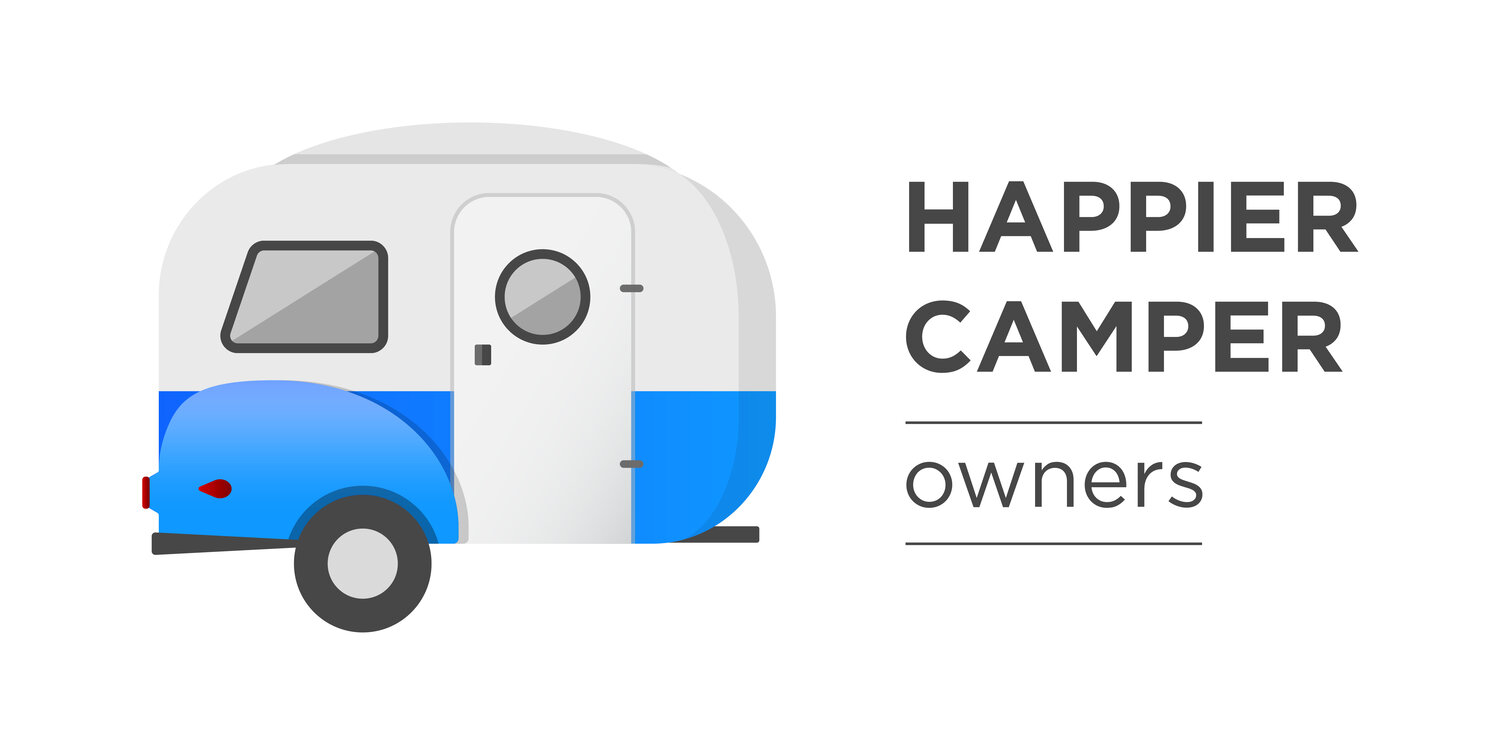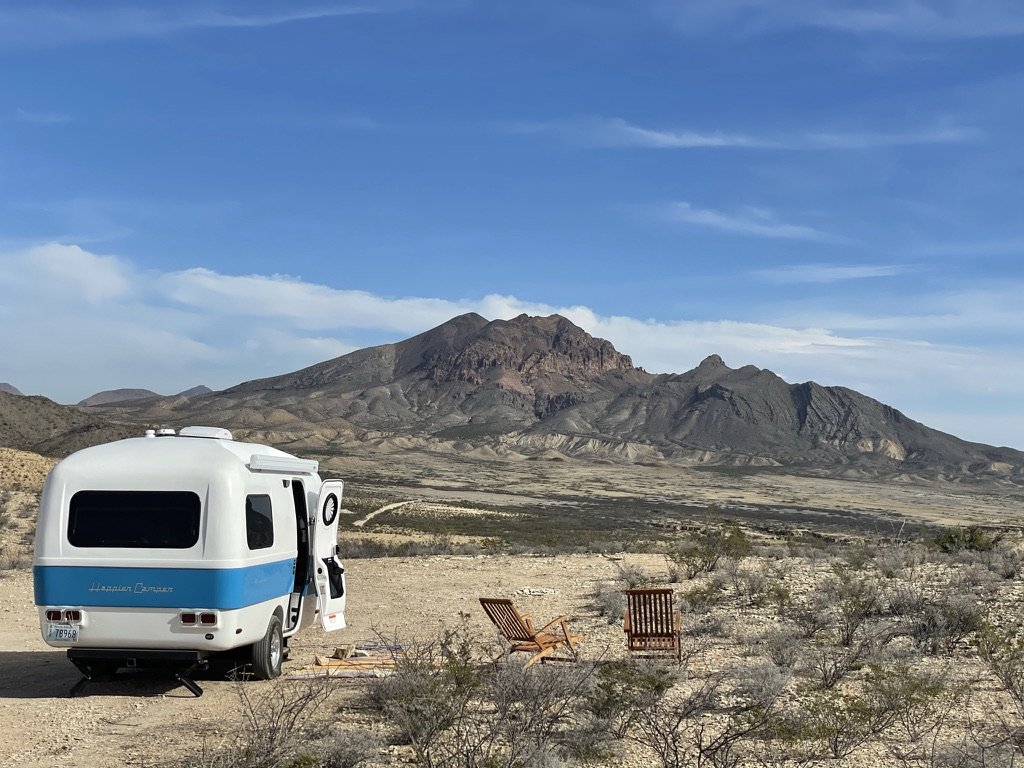I see a lot of posts from people on social media where they feel uncomfortable that they don’t know the right term to use on a camping topic. I get it - we are surrounded by people with deep knowledge of all things camping and most of us are just trying to not look like an idiot asking if dry camping and boondocking are the same thing (they are - sort of!). Let the experts do their experting - we need and love them and their knowledge, but if you are like me and just want a slightly better grasp on some of the terms you commonly see, read on!
Boondocking vs. Dry Camping
Boondocking refers to camping with no municipal source - no electric, water or sewer hookups - AND you don’t have a reservation. It’s actually a slang term for dispersed camping, which I hear used less frequently (but which is used by federal agency websites). That picture of a Happier Camper HCT in the middle of the desert? They are boondocking. Have a reservation at your local state park where they have no water/electric/sewer hookups? That’s dry camping (it’s the reservation that makes the difference).
Power inverter vs. charge controller
A power inverter takes DC power (think something you plug into a cigarette lighter in the car) and converts it to AC (think plugs in your house). If you want to be able to charge your laptop when you are boondocking and you have the solar package, you will need an inverter, otherwise only the DC/cigarette lighter outlets will work. Check out an article I wrote called the Power Article for more info on this topic. A charge controller is doing something totally different. If you’ve bought a rig with solar already installed, there should be a controller to regulate the voltage and current coming from the panels going to the battery. It basically protects your battery from over-charging. So the charge controller keeps your battery safe. The power inverter lets you use that power for something that needs a house-type plug. And if you are like us and like a back up plan for power, we also bought this Jackery 500 with solar panels.
Our bucket list trip to Big Bend with our 2020 HCT
Self-contained
If you are self-contained, you don’t need a full hookup and can go boondocking! As you might have guessed, it means that your rig can provide for your electric, water and drainage/storage needs, but it is often said in the context of your gray and black water. If you’ve heard of Harvest Hosts, you will know that they require you to be self-contained to be a member.
Gray and Black Water
Gray water is the water that is a product of doing things like taking a shower or washing dishes. If your rig doesn’t have a gray water tank built in, you can always use a portable one. When we had an HC1, we carried one like this so that we could use the kitchenette and be self-contained. Black water is your toilet water. I know of only two options to be self-contained for your black water. The first is to have a black water tank on your rig. This is a tank that is connected to your toilet and you have to find a dump station to empty it. The other options do not require a black water tank and are things like a composting toilet or Happier Camper offers the Laveo Dry Flush toilet.
Three River Petroglyph campsite, with hookups
Bureau of land management (BLM)
The BLM manages one in every ten acres of land in the United States, which is sort of mind blowing when you think about it. Their mission is to sustain the health, diversity and productivity of public lands for the use and enjoyment of present and future generations and if you are reading this, what that translates to is free or near free camping! I will have a separate article specifically about how to find & camp on BLM land but check out their website to learn more about this amazing agency. In some cases, a BLM site will have camping spots with water and electric hook ups. We stayed at the Three River Petroglyph site in New Mexico and paid $7 a day.
Full Hook Up
Having a full hookup just means that the campsite provides you with electric, water and sewer hook ups. Sometimes they will specify electric and water only, which isn’t a full hookup but it is close! At our campsite at Three River Petroglyph, we had a partial hookup of water and electric
Shore Power
This is a nautical term that somehow made its way into camping lingo and it means that you have an electric hook up. Even though we have solar on our rig, we will top up the battery by hooking up to shore power whenever we can.
Weight distribution system vs. sway bar
Imagine a cartoon where a small vehicle is towing something big. It would probably be drawn with the back of the car being pulled down and maybe the front tires off the ground. In our real life version, the back of the car would sort of sag and the front of the vehicle is lifted - and you don’t have as much control when you are driving. It’s a big reason for trailer sway which is that crazy moment on the highway when you really wish you were somewhere else. A weight distribution hitch will more evenly distribute the weight, minimize the sag and as a result, make sway less likely - and they are often required for trailers of a certain weight. A sway bar is not going to distribute the weight more evenly between the trailer and the tow vehicle - it’s just going to minimize sway. A sway bar uses friction to keep your trailer centered with your tow vehicle - if the trailer starts swaying it acts as a sort of side to side brake. The Happier Camper HC1 and HCT do not require a weight distribution hitch because they are so light weight. I know of almost no HC owners that use a sway bar either - with one exception. There is a person that bought a rig that had been owner-customized with a wooden bunk bed and that install did cause the rig to sway more, so they bought a sway bar.
Back up camera vs. full rearview mirror
The petroglyphs at Three River Petroglyphs are amazing and very accessible - an easy beginner’s hike
A back up camera will be installed in any tow vehicle after 2018 in the US by law. When you put the car in reverse, a camera automatically turns on and there will be a built in display, likely with two parallel lines, that let’s you see directly behind you. The camera is usually mounted right above the license plate and is super helpful when reversing into a parking spot or when you are trying to line up your tow hitch with the coupler so you can hook up and go. If you have a tow vehicle dating before 2018, you probably don’t have what, at the time, would have been an expensive upgrade. An after-market full rearview mirror is how you get the benefit of a back up camera if it didn’t come with the car. The camera is mounted in the rear of the vehicle and you see the display in the rearview mirror itself. If your tow vehicle is pre-2018 and doesn’t have a built in back up camera, here is a link if you want to check one out.
What else do you want to know?
Hopefully this gives you a little more confidence with some basic terms. What didn’t I cover here that you want a primer on?! Leave a comment below and I will start Part 2.




